The Tabernacle, 1886 – 1933
The Alter Place of Sam Porter Jones’ Old Time Revivals
By: Joe F. Head
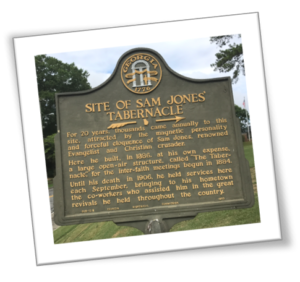
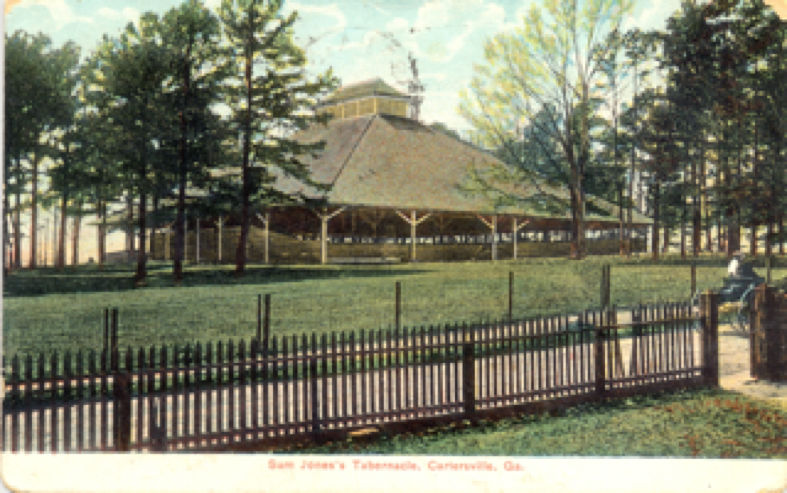
Photo courtesy of the Bartow History Museum
Today only a single state historic sign remains as evidence of a legendary tabernacle site that marked Cartersville as once being the religious epicenter of Georgia and perhaps the southeast. This piece of Bartow history has not benefited from a collective story or focus and therefore has escaped deserving attention. However, its story is worthy of examination and should hold a dedicated place in Bartow history.
For two decades beginning in 1886, the Methodist rock star evangelist Sam Jones preached hell fire from a pulpit in a wooden structure resembling an open – air picnic pavilion that seated up to 5000 attendees. Here he typically held annual revivals every August or September with the vigor of gospel thunder and powerful voice of a mighty saint. His style of witty preaching, handsome appearance and fierce delivery of the gospel combined with an oratorical skill for spiritual awakening was renowned. Sam’s pulpit presence drew people from far and wide. He often preached on the evils of whiskey and mean spirited living.
Specially chartered trains were scheduled daily from Atlanta and Chattanooga to bring 100’s of people to hear his scorching sermons. Others walked or arrived by horse back and buggy. The sermons were preached several times daily and lasted for up to two weeks. Attendees would stay in hotels, boarding houses, rent from locals, stay with relatives or camp out around the Tabernacle grounds for the duration of the revival. Hence, the term, “Gospel Camp Meeting” or “tent revival” emerged from such outside evangelical worship services.
Neil Diamond’s 1969 rock & roll classic, Brother Love’s Traveling Salvation Show aptly describes a time long ago when people attended outside revivals in the heat of summer nights and relished in finding the Lord in spiritual camp meetings. Preachers would serve up sermons filled with images of hell, pranced with animation on the platform, reviled sin, pounded the lectern, waved the Bible and beckoned for souls to accept salvation at the foot of the alter. Attendees would pitch tents, make camp and were thrilled to hear the message and rejoiced in singing old time gospel hymns.
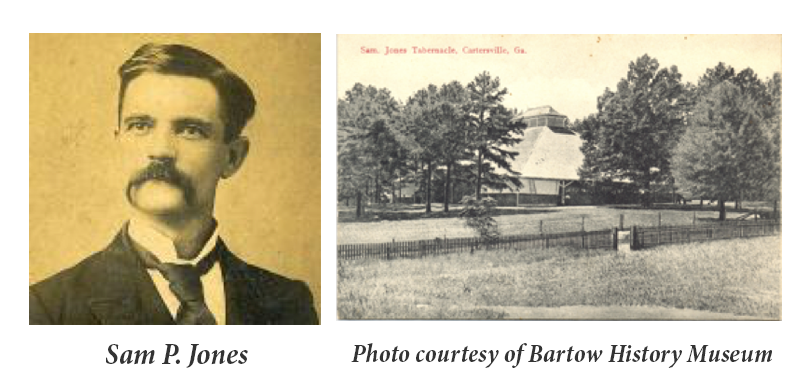 Reverend Sam Jones was born 1847 in Oak Bowery, Alabama, but reared in Cartersville. His formative years were filled with hard work. As a young man Sam labored in a foundry and drove freight wagons. His father was a Captain in the Confederate Army and later practiced law.
Reverend Sam Jones was born 1847 in Oak Bowery, Alabama, but reared in Cartersville. His formative years were filled with hard work. As a young man Sam labored in a foundry and drove freight wagons. His father was a Captain in the Confederate Army and later practiced law.
Sam followed in his father’s law profession, but suffered from depression and fell into alcoholism. Upon his father’s deathbed, steeped in guilt and impending loss of his father, Sam repented and swore to give up his wicked life and defy the evils of liquor. Here … began his journey to become one of America’s most legendary evangelists.
In 1884 a grand bush-arbor revival meeting was held in Cartersville and preached by the Reverend J. B. Robbins and Dr. T. F. Pierce. Records indicate that 68 people accepted Christ as a result of the meeting. It is thought that this event was the origin of the Sam Jones Camp Meetings. As many clergy of the day, Sam Jones did not have a fixed church, but was a circuit rider assigned to the Van Wert district. However, his talent for speaking, humor and preaching drew enormous crowds.
A history found in the archives of the Sam Jones United Memorial Methodist Church suggests that the 1884 outside revival likely inspired his idea for the success that an open – air tabernacle could offer. He saw opportunity for reaching greater numbers of people and supplementing his income by using the revival as a tool to meet his calling.
Two years following the bush-arbor revival, Sam Jones proposed to the city of Cartersville to furnish him with ten acres of land on which he would build a tabernacle to preach the gospel. Records reflect that the city complied providing him with a property west of town where Sam Jones built the facility from his personal funds.
A June 17, 1886 article entitled, The Tabernacle, appeared in the Courant American newspaper and reported that a number of citizens met in the Opera House (Grand Theater vicinity) to consider Rev. Sam Jones’ proposal to erect a tabernacle. Business leaders attending the meeting realized the great good that would bring to the community if such an institution were established. The motion was approved; board of trustees appointed and work on the tabernacle began soon after. The trustees consisted of: R. H. Jones, R. M. Pattillo, W. H. Howard, J. T. Owen, T. W. Akin, S. L. Vandivere and E. D. Graham.
According to deed records the board assembled a tract of land in two separate purchases. The first was from Mr. Thomas W. Milner on September 16, 1886 in the amount of $500.00. A second purchase adjoining the first was made from Mr. William M. Graham on July 23, 1888 for $155.00. Interestingly, the trustees quickly conveyed a portion of Tabernacle land to the newly formed and incorporated Sam Jones Female College on November 4th, 1886.
The tabernacle was built on the corner of West Main and Lee Street, property now occupied by the Cartersville Civic Center and Bartow County Library near the former Cherokee Elementary School and site of the former Sam Jones Female Academy. The Academy was a separate project intended to provide seminary training and college options for young ladies. Contrary to innocent beliefs, the Tabernacle nor the Sam Jones Female Academy were not under the authority of the local Methodist (Sam Jones) Church. (Formerly, Cartersville Methodist Episcopal Church South)
According to ads posted in the Courant American newspaper, it appears the facility was named, The Sam Jones Union Tabernacle. Newspaper articles indicate the first Tabernacle Revival was a tent meeting in 1886. What appears to be the first Sam Jones Tabernacle structure meeting was held September 9th, 1887 featuring a slate of impressive ministers to preach at four scheduled services each day with the revival running for 10 days. The ad also boasts that the W&A and East & West RR will offer excursion rates. On the final day Sam Jones preached to an estimated crowd of 6000.
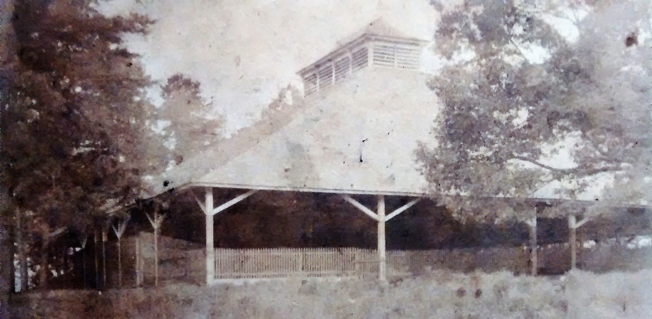
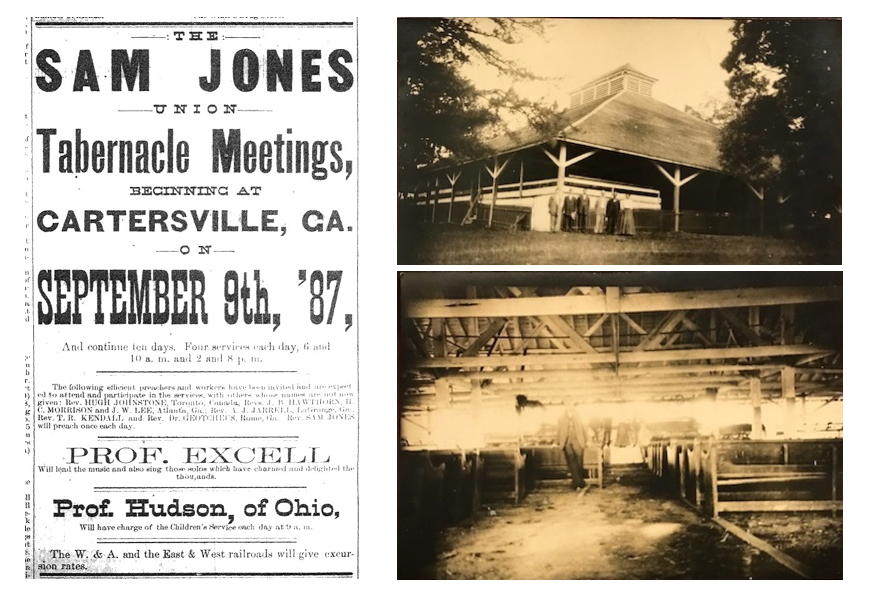
An August 15, 1887, article entitled “The Gospel Truths” describes how the trustees improved the Tabernacle grounds and building as follows. A white picket fence was built around the Tabernacle with gates on all street fronts, half of the pews are now equipped with seat backs, bright chandeliers and electric lamps, the rostrum has been increased to hold up to 1200 singers, piano and organ installed, a sprinkler system added to reduce the grounds dust and a baggage check room, so parties may not be burdened with bundles and baskets.
During its hay day, the Tabernacle revivals attracted people from all over the southeast arriving on special chartered trains. Local oral history recalls that when trains arrived the traveling parties would band together and march in parade style from the depot on West Main Street to the Tabernacle while singing gospel songs.
Following revivals short articles often appeared in the newspaper that praised Sam Jones and the Tabernacle. One article even invites the state legislature to the Tabernacle and declares that they do not know of any body needing the influence of the doctrine more. Other comments declare the Tabernacle meetings to be highly successful and making Cartersville and Bartow the Mecca of Christians everywhere.
Often compared with the 21st century Rev. Billy Graham and contemporaries of the 1890’s such as Billy Sunday, Dwight Moody, Bob Jones and others, Sam Jones became a Georgia treasure. His reputation grew rapidly and he began to receive invitations to preach across the nation from Atlanta to California. His reputation and influence were embraced by great cities such as Chicago, New York and Boston, north and south. His impact was so significant in Nashville, Tennessee that the noted Ryman riverboat shipping family built him an auditorium in which to preach. Later the auditorium became the Mother Church of the Grand Ole Opry.
In 1890 the City of Cartersville acquired the Sam Jones Female College and established the first city high school. A year later the first Cartersville graduation was held at the Sam Jones Tabernacle. The Tabernacle was decorated with tri-color bunting, overhead red, white and blue streamers with the class motto, “Knowledge is Power” secured to the rostrum for all to see.
 Sam Jones always returned to Cartersville where he lived in his beloved Roselawn estate just two blocks from the Tabernacle. Even today, the rear of his home is flanked by a street named for the famed facility and is called, Tabernacle Street leading to the former camp meeting site.
Sam Jones always returned to Cartersville where he lived in his beloved Roselawn estate just two blocks from the Tabernacle. Even today, the rear of his home is flanked by a street named for the famed facility and is called, Tabernacle Street leading to the former camp meeting site.
Frequently compared to the massive voice of George Beverly Shae, of the Rev. Billy Graham crusades, Annie Laurie Jones Cunyus, great niece of Sam Jones was featured as the lead vocalist at his revivals. She was also the pianist at the Tabernacle meetings. Laurie carried the nickname, “Beautiful” referring to her angelic voice. Annie often accompanied Sam Jones to many of his national revivals.
Reverend Jones’ health began to visibly deteriorate several years before his death. An article appeared in the Cartersville News and Courant in June 1904 speaking of a revival he was to conduct in Rome, Georgia. His arrival was delayed by three days due to his illness and the paper stated that he was physically weak with physicians advising that he not deliver the sermons. He ignored doctor’s counsel and held the revival regardless. The crowds noted how weak he was and he immediately departed to Cartersville for rest and recuperation.
The Tabernacle meeting held in September 1906 would be the last Sam Jones would ever preach at this site. The September 27, 1906 edition of the Cartersville Newspaper reported that revival was his most successful. Attendance exceeded 20,000 for the week and reached over 6000 on the final night. The following October while returning on a train from a revival in Oklahoma, Sam Jones suffered a heart attack and died while traveling through Arkansas. Ironically, the title of his final mortal sermon was, “Sudden Death.” His body has been the only non-political personality to lie in state at the Georgia State Capital. Thousands of people greeted the funeral train in Atlanta and Cartersville. He was laid to rest at the Oak Hill Cemetery in Cartersville. An impressive monument stands watch at his grave today.
Meetings continued annually for four decades with revivals scheduled in May, July, August or September. Each meeting featured well known evangelists including: Bob Jones, Sam Small, Bishop Warren A. Candler, Gypse Smith, Sr, Walt Holcomb, Luther Bridges and many others.
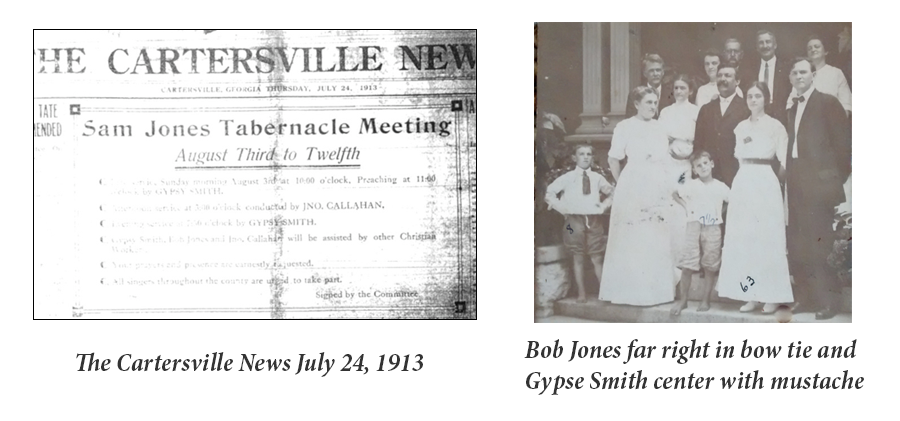
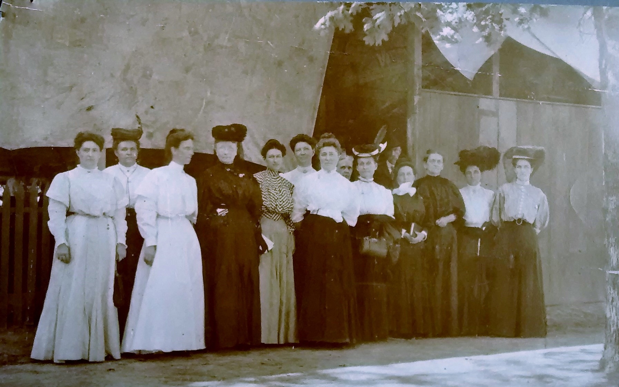
Mrs. Sam “Laura” Jones, stands 3rd from right wearing black with a group of community women at the Tabernacle following the funeral of Sam Jones.
Following the death of Sam Jones, a group of “Prominent Church Men” launched a plan to sustain the annual Tabernacle revivals. Along with a group of local church and community leaders they requested a petition for a new charter which appeared in the Bartow Tribune News December 17, 1915. A new board of trustees including Mrs. Jones was formed to carry out the purpose. The Board was comprised of W. C. Walton, N. A. Bradley, E. W. Robinson, J. W. Vaughn, A. J. Collins, H. E. Young, J. M. Smith, J. B. Foster, W. D. Donehoo, R. G. Gilreath, H. C. Nelson and representation of the major churches in Cartersville. The initiative was named the “Sam Jones Tabernacle Association and Bible Conference.” The objective was to be an “all – denominational” body and serve as an evangelical union to preach and teach the Bible. A new charter was issued in 1915, for twenty years and stipulated a number of local churches to be represented on the Board. Mrs. Jones was appointed for life.
By 1913 a contentious revival season surfaced over the proposal to name the colorful, but controversial Reverend Bob Jones as the official Revivalist to lead the Tabernacle in its evangelistic mission. Articles appeared in the Atlanta Constitution and religious journals about the discord unfolding at the great Sam Jones Tabernacle. Three local clergy representing the First Baptist Church (J. M. Long), First Presbyterian Church (L. G. Hames) and Methodist Church (W. T. Hunnicut) withdrew from the Tabernacle Committee in opposition of appointing Bob Jones as the chief evangelist. Armed with a petition of more than 400 signatures the layman committee refused to ignore the congregation’s wishes to invite Bob Jones as the primary speaker for the foreseeable future. It was felt that the clergy were threated by Bob Jones and were jealous of not being invited to lead the revivals.
The Tabernacle began to be used for a variety or programs including singings, Jones family reunions, civic programs, special sermons and rallies.
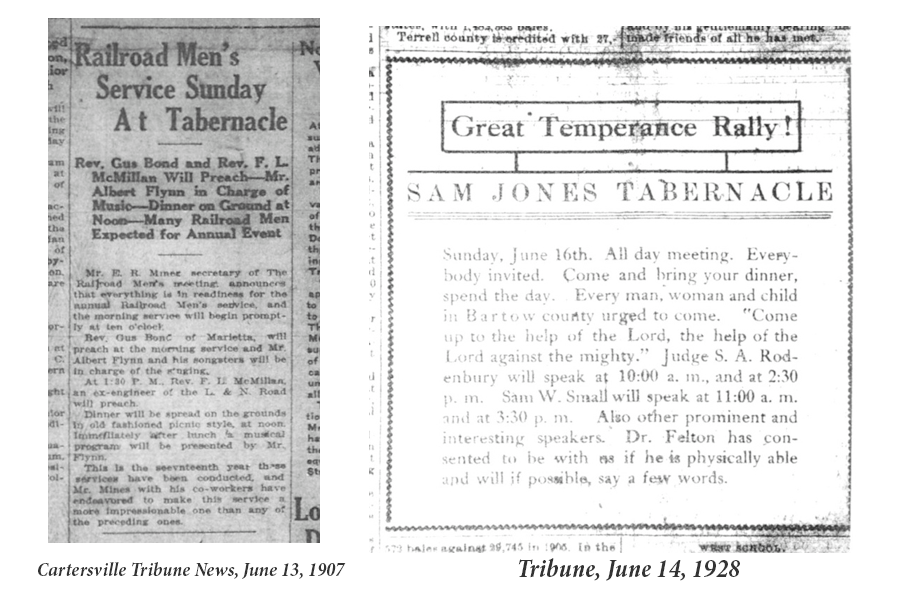
In the 1920’s the Association began to publish financial reports in the newspaper indicating revenue and expenses. One report reflected specific disbursements and amounts including fees to speakers, travel, hauling pianos, lighting, night watchman, saw dust, printing, pianist, newspaper ads, hotel and sundries.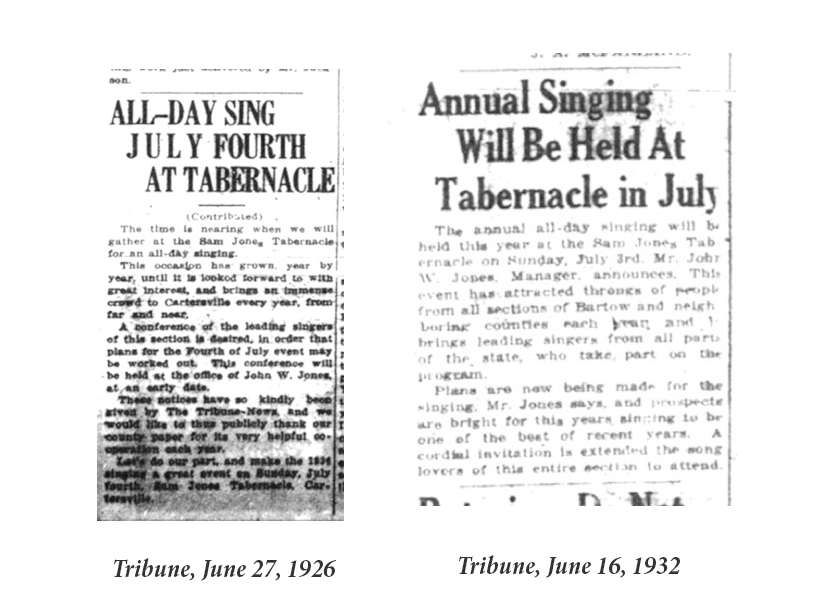
The Board attempted to continue business as before by scheduling high powered speakers. However, by the latter part of the 1920’s newspaper ads began to reveal changes that signaled a demise of the Tabernacle. Revivals began to be shortened from two weeks to one and then to the point that they were promoted as “All Day Singings” and not called revivals. Dates were moved to mid summer and coincided with the 4th of July in repetitive years. Patriotic hymns and Negro spirituals were featured. By the late 1920’s John W. Jones (Cousin to Sam Jones) is taking an active role in arranging the one – day annual singings. Newspaper ads began to decrease in size as did the length of follow up articles reporting attendance and review of sermons.
Mrs. Sam “Laura” Jones kept a diary now in the possession of her great grandson Mr. Howell Jones of Atlanta. She often wrote of the Tabernacle revivals. The following is an excerpt of the final meeting preached by Sam Jones at the Tabernacle.
“Sept.16, 1906: splendid meeting 10,000 people at meeting Mr. Jones (Sam) preached a wonderful sermon. Sept 22, 1906: crowds grow every day and meetings are splendid – had 51 for dinner Sept.23, 1906: red letter day 22,000 people here – meetings closed tonight with a grand meeting.”
By 1933 ads promoting the annual event and one day singings ceased. It appears operations terminated and the Tabernacle sat idle. The Tabernacle Association was not heard from again until late 1939. On January 11, 1940 an announcement appeared in the paper calling all trustees to an important meeting at the Chamber of Commerce.
Pursuant to the Board meeting a January 18, 1940 article appeared announcing the decision to sell the Tabernacle to the City of Cartersville with an understanding the property would become a playground. A cash balance of funds remained and was signed over to the associated charities. A deed was recorded February 2, 1940 in deed book 76, page 271 filed by association executive officers Ben C. Gilreath, President and M. L. Fleetwood, Secretary. This action officially closed a half century of Sam Jones evangelism in Bartow County. Ben Gilreath became an advocate of appropriating playground space for the city schools and announced later that the Tabernacle property would be officially known as the Sam Jones Memorial Playground.
In retrospect, the City of Cartersville has yet to produce an equal celebrity as that of the Rev. Sam Jones. With the exception of a possible state championship football game, no other event or person has drawn so many people to this community. For half a century Sam Jones and his Tabernacle annually attracted tens of thousands of people to this small north Georgia town to hear the gospel.
The Tabernacle is both a religious and city legacy that should not be forgotten.
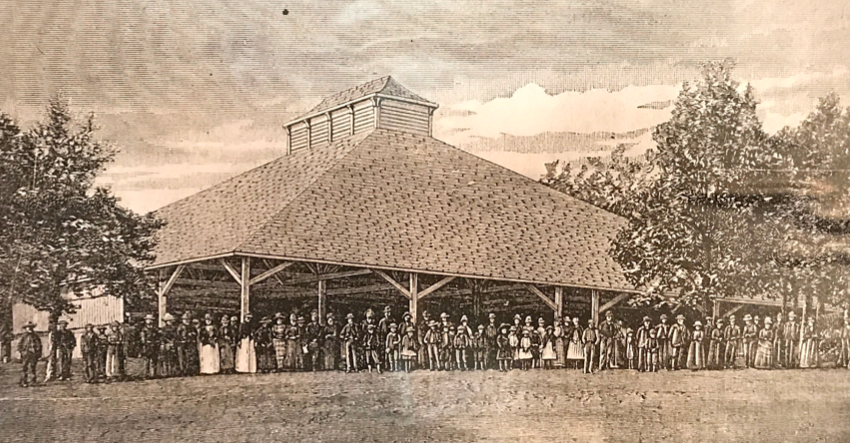
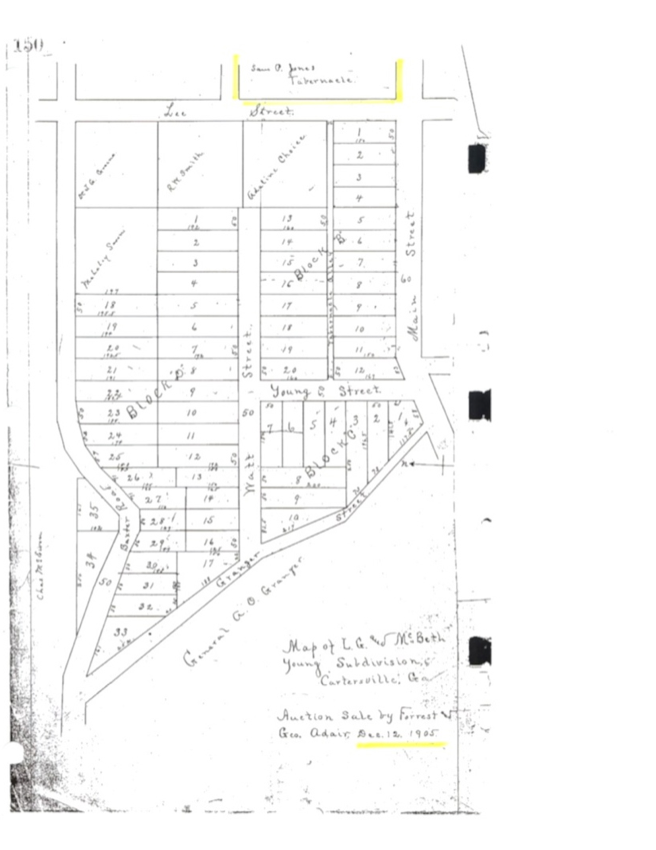
(Lot 484) 1905 Granger Hill plat with Sam Jones Tabernacle indicated at top
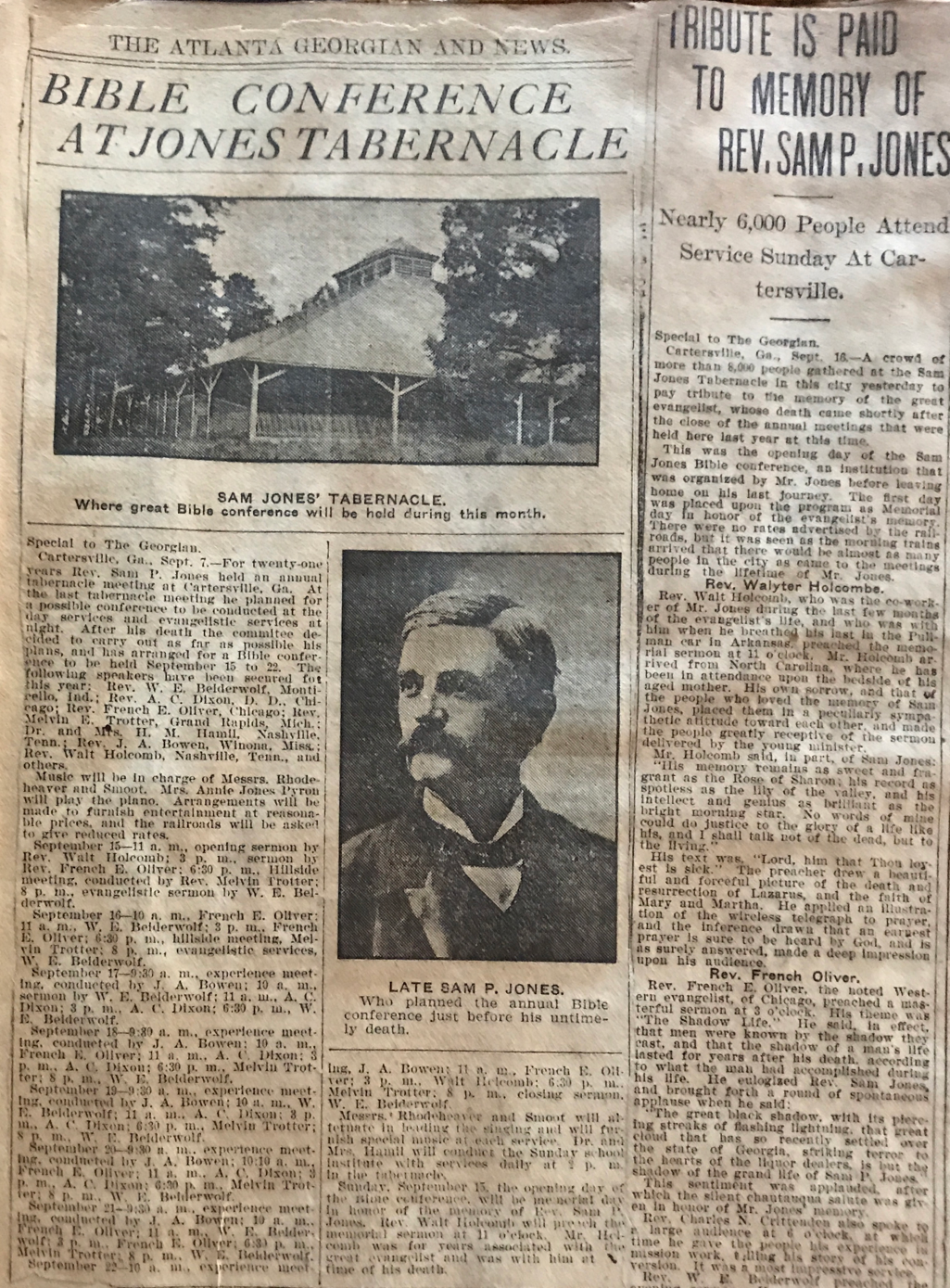
Conclusion
The Tabernacle existed for about 47 years and held lively revivals and singings for most of its life having skipped only two or three years. Until now only a scattered patchwork of information and stories existed about the legendary Tabernacle.
No central work has been available and dedicated to the once thriving gospel temple. A narrative of the Tabernacle serves to better complete the story of Sam Jones and his revival legacy. This work is intended to provide a collective document of facts and photos that exist about the long forgotten worship center.
Photos Courtesy of Howell Jones
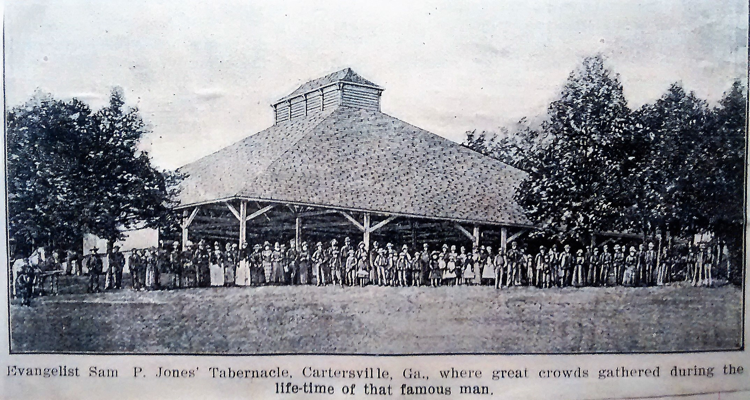
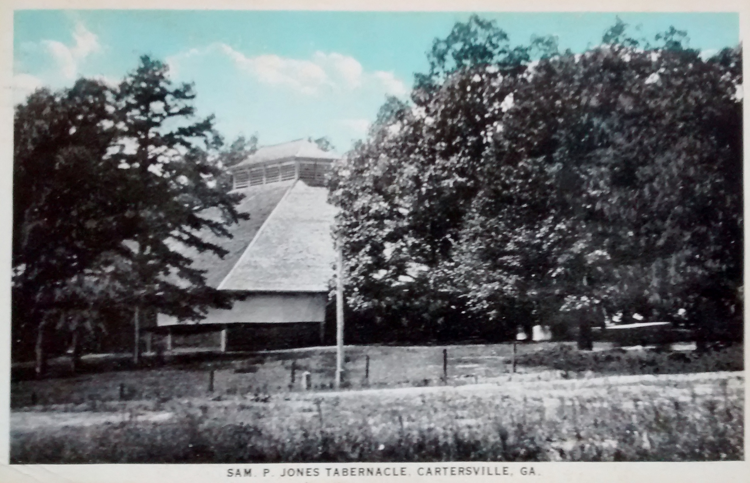
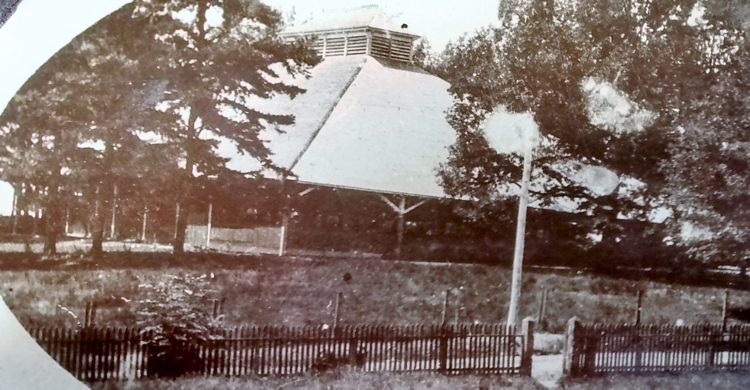
Reverend Sam Jones Revival sites
These are known cities that Rev. Samuel P. Jones held revivals during his career. However, this list is not inclusive and does not account for return or repeat visits at listed sites. It is well known he returned multiple times at many of these locations. Each revival attracted tens of thousands of people that converted 100’s to Christ at each meeting. Revivals met for 2 to 3 weeks each holding 2 and sometimes 3 sermons each day.
Source: Reverend Scott Sheppard, Brandon’s Chapel, Stilesboro, GA
Alabama
Birmingham
Huntsville
Mobile
Montgomery
Oak Bowery
Selma
Tuscumbia
California
Los Angeles
Sacramento
San Francisco
Georgia
Athens
Atlanta
Augusta
Barnesville
Brunswick
Calhoun
Cartersville
Cave Spring
Central
Columbus
Covington
Crooked Creek
Dalton
Decatur
Eatonton
Edgewood
Griffin
LaGrange
Lexington
Macon
Madison
Marietta
Monticello Circuit (Jasper Co.)
Newnan
Newton Co
Oothcaloga
Pickens Co
Rockmart
Rome
Savannah
Thomson
Van Wert Circuit (Bartow, Floyd, Paulding, Polk)
Waycross
Westpoint
Illinois
Chicago
Indiana
Indianapolis
Kentucky
Bowling Green
High Bridge
Hopkinsville
Louisville
Owensboro
Paducah
Louisiana
Monroe
New Orleans
Massachusetts
Boston
Maryland
Baltimore
Maine
Unknown
Minnesota
Minneapolis
St. Paul
Missouri
Kansas City
Mineral Springs
Plattsburg
St. Joseph
St. Louis
Mississippi
Aberdeen
Columbus
Corinth
Greenville
Luka
Jackson
Meridian
West Point
Vicksburg
North Carolina
Asheville
Charlotte
Durham
Greensboro
Raleigh
Wilkesboro
Wilmington
Winston Salem
Nebraska
Omaha
New York
Brooklyn (Tabernacle)
Rochester
Round Lake
Saratoga Springs
Ohio
Cincinnati
Oklahoma
Oklahoma City
South Carolina
Charleston
Tennessee
Chattanooga
Jackson
Knoxville
Memphis
Monteagle
Murfreesboro
Nashville
Texas
Dallas
Danville
Fort Worth
Galveston
Houston
Lynchburg
Palestine
San Antonio
Tyler
Waco
Virginia
Richmond
Roanoke
West Virginia
Mound
Unknown
DeSoto circuit
New Bern circuit
Canada
Toronto
Sources and Bibliography
Acknowledgements
Jane Drew, Director Roselawn Museum
Catrina Sheppard, Roselawn staff
Howell Jones, Great Grandson to Sam and Laura Jones
Lynn Gentry, Bartow County Deeds Office
Tina Shadden and Sandy Moore, Bartow History Museum
Nathan Thompson, Freelance Title Researcher
Sam Jones United Memorial Methodist Church
Bartow History Museum
Resources
History of Sam Jones United Memorial Methodist Church, 1838 – 1963
Sam Jones, An Ambassador of the Almighty, Walt Holcomb
The Life and Sayings of Sam Jones, Laura Jones
Sam Jones a Fire Out of Georgia, Ray Hughes
History of Bartow County, Lucy Cunyus
Cartersville Public School Centennial 1888-1988, 100 Year History
Newspapers
The Courant American, The Tabernacle, June 17, 1886
The Courant American, Revival Ad, August 18, 1887
The Courant American, Editorial Comment, August 15, 1887
The Courant American, The Gospel Truths, August, 15, 1887
News and Courant, Rev. S. P. Jones Ill, June 9, 1904
Cartersville News, Tabernacle Meetings to Open Tomorrow, September 13, 1906
Cartersville News, The Crowd Sunday Record Breaker, September 27, 1906
Cartersville News, Rev. Sam P Jones Claimed by Death, October 18, 1906
Cartersville News, Tabernacle for 1907, November 29, 1906
Cartersville News, Great Temperance Rally, June 13, 1907
Bartow Tribune, Petition for Charter, December 19, 1915
Tribune News, $1,375.12 Was Collected for Tabernacle, September 9, 1920
Bartow Tribune News, Report on Tabernacle Income, October 18, 1923
Tribune News, Sam Jones Tabernacle Meeting July 20th, July 10, 1924
Tribune News, All Day Sing July Fourth at Tabernacle, June27, 1926
Tribune News, Railroad Men Service at Tabernacle, June 4, 1928
Tribune News, John W. Jones Planning for Annual Singing, May 29, 1930
Tribune News, Ben C. Gilreath Urges Space for Playgrounds, April 6, 1939
Tribune News, Tabernacle Group Meets Friday, January 11, 1940
Tribune News, Sam Jones Tabernacle Goes to City, January 18, 1940
Deed/Business Records
Deed book 2, page 80 and 81, initial land purchase for Tabernacle
Deed book 2, pages 710 and 711, second land purchase for Tabernacle
Deed book 2, page 81 and 82, conveyance of Tabernacle parcel to Female College
Deed book V, 153 and 154, transfer Tabernacle to new board and charter
Deed book 76, pages 271 and 272, sell of property to City of Cartersville, 1940
Business Charter Book, EVHS Office, pages 465 – 472

